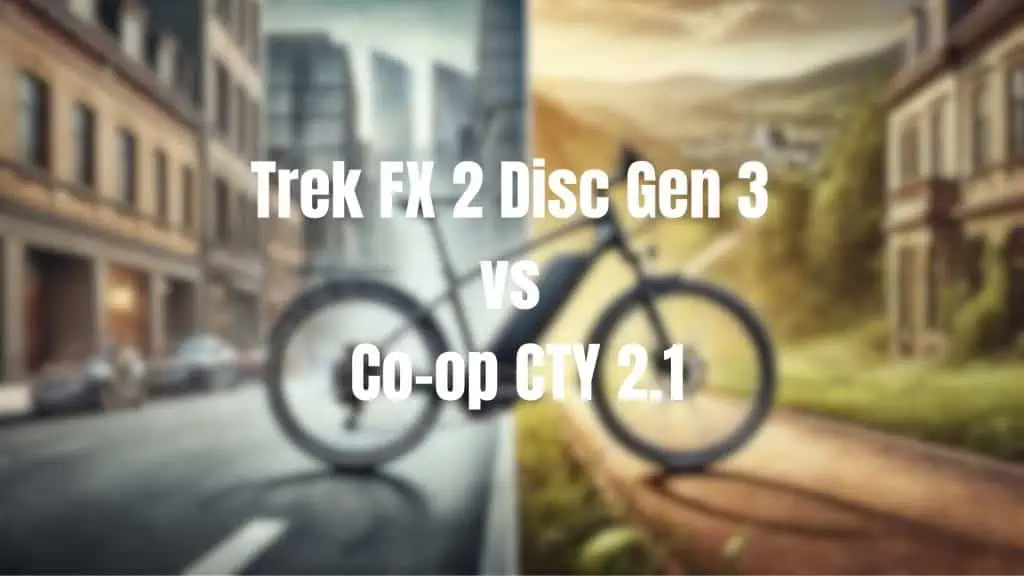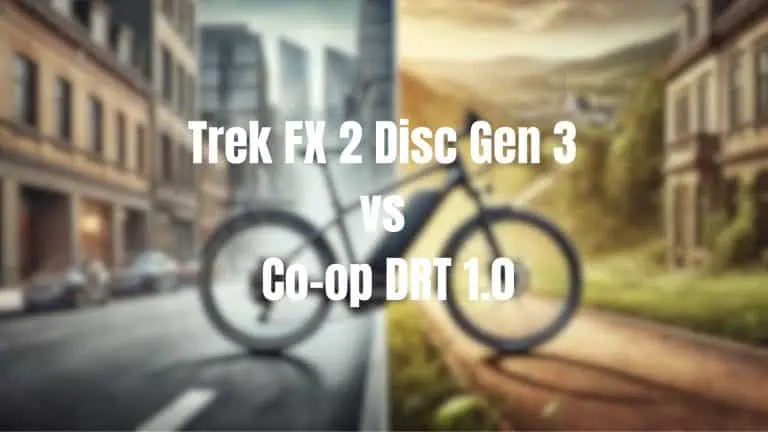Trek FX 2 Disc Gen 3 vs Co-op CTY 2.1

Trek FX 2 Disc Gen 3 and the Co-op CTY 2.1 are both hybrid bikes designed for urban riding and light trails. While they share many similarities in their overall purpose, there are some key differences that could make one more suitable for certain riders. This detailed comparison will help you understand the nuances of each model to determine which might be the better fit for your cycling needs.
Comparison Table
| Feature | Trek FX 2 Disc Gen 3 | Co-op CTY 2.1 |
|---|---|---|
| Price | $799.00 | $799.00 |
| Bike Type | Hybrid Bike | Hybrid Bike |
| Frame Material | Alpha Gold Aluminum | 6061 aluminum |
| Wheel Size | 700c | 700c |
| Suspension | No Suspension | No Suspension |
| Drivetrain | Shimano | Shimano |
| Gearing | 18 gears | 16 gears |
| Brakes | Hydraulic Disc | Hydraulic Disc |
| Weight | 26 lbs | 30 lbs. |
Price and Value
Both the Trek FX 2 Disc Gen 3 and the Co-op CTY 2.1 are priced at $799.00, putting them in direct competition with each other in terms of value. This identical pricing suggests that the choice between them will likely come down to specific features and brand preferences rather than cost.
Bike Type and Frame Material
Both bikes are classified as hybrid bikes, designed for versatile use primarily in urban environments with the capability to handle light trails:
- Trek FX 2 Disc Gen 3: Alpha Gold Aluminum
Trek’s Alpha Gold Aluminum is their higher-grade aluminum, known for its light weight and strength. It’s a step up from their standard aluminum frames. - Co-op CTY 2.1: 6061 aluminum
6061 aluminum is a common and reliable material for bike frames, known for its strength, lightweight properties, and corrosion resistance.
While both use aluminum alloys, the Trek’s Alpha Gold Aluminum might have a slight edge in terms of engineering and potentially ride quality.
Wheel Size
Both bikes feature 700c wheels, which are standard for road and hybrid bikes. This wheel size provides good rolling efficiency and speed on paved surfaces, while still allowing for slightly wider tires to handle light off-road use. The consistency in wheel size means that both bikes will have similar characteristics in terms of rolling resistance and the ability to maintain speed.
Suspension
Neither bike features suspension, which is typical for many urban-focused hybrid bikes. The lack of suspension helps keep the weight down and improves pedaling efficiency on paved surfaces. This design choice indicates that both bikes are primarily intended for use on roads and smooth paths rather than rough terrain.
Drivetrain and Gearing
- Trek FX 2 Disc Gen 3: Shimano, 18 gears
- Co-op CTY 2.1: Shimano, 16 gears
Both bikes use Shimano components, which are known for their quality and reliability. The Trek FX 2 offers slightly more gears (18 vs 16), potentially providing more options for fine-tuning your pedaling effort across various terrains and speeds.
The difference in gearing is minimal and unlikely to significantly impact most riders. Both systems offer a good range for urban riding and light trails.
Brakes
Both bikes feature hydraulic disc brakes, ensuring excellent stopping power and control in various conditions. This is a tie in terms of braking performance, with both bikes offering top-tier braking systems for safety and control in urban environments and light trail use.
Weight
- Trek FX 2 Disc Gen 3: 26 lbs
- Co-op CTY 2.1: 30 lbs.
The Trek FX 2 Disc Gen 3 is 4 pounds lighter than the Co-op CTY 2.1. This weight difference is noticeable and could impact the bikes’ handling and ease of transport. The FX 2’s lighter weight could make it more agile and easier to accelerate, while also being easier to carry up stairs or lift onto a bike rack.
Riding Position and Comfort
Both bikes likely offer a relatively upright riding position, typical of hybrid bikes:
- This position provides good visibility in traffic and comfort for urban riding.
- The geometry of both bikes is designed to balance efficiency and comfort, suitable for longer rides and daily commutes.
Any differences in comfort would likely come down to individual fit and personal preference, as both bikes are designed with urban riding and light trails in mind.
Which is Better?
The choice between the Trek FX 2 Disc Gen 3 and the Co-op CTY 2.1 depends on your specific needs and preferences:
- Weight: If you prioritize a lighter bike for easier handling and transport, the Trek FX 2 has a clear advantage.
- Gearing: The Trek FX 2 offers slightly more gears, which might be beneficial for riders who want more precise control over their pedaling effort.
- Frame Material: Trek’s Alpha Gold Aluminum might offer a slight edge in terms of ride quality, though this could be subtle and subject to personal preference.
- Brand Preference: Trek is a well-established global brand, while Co-op is REI’s house brand. Some riders might prefer the Trek for its brand recognition, while others might appreciate the value and customer service associated with REI’s Co-op brand.
- Availability: Depending on your location, one bike might be more readily available or easier to test ride than the other.
In conclusion, both the Trek FX 2 Disc Gen 3 and the Co-op CTY 2.1 offer excellent value for urban riders looking for a versatile hybrid bike. They share many key features, including hydraulic disc brakes, aluminum frames, and Shimano components.
The Trek FX 2 Disc Gen 3 might have a slight edge for riders who prioritize lower weight and want the maximum number of gearing options. It could be the better choice for those who frequently need to carry their bike or want the most responsive ride possible.
The Co-op CTY 2.1, while heavier, still offers a great range of features at the same price point. It could be the preferred choice for riders who appreciate REI’s customer service and return policy, or for those who find the bike fits them better.
Given the similarities between these bikes, it would be ideal to test ride both if possible, as personal feel and fit can be the deciding factors when choosing between two closely matched bikes.






